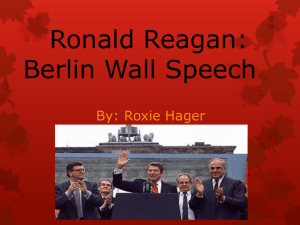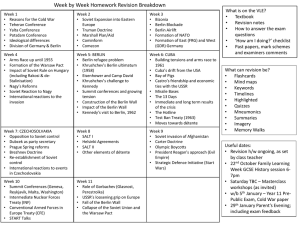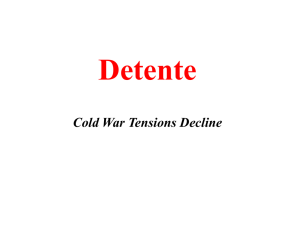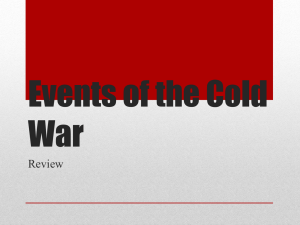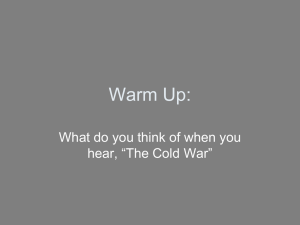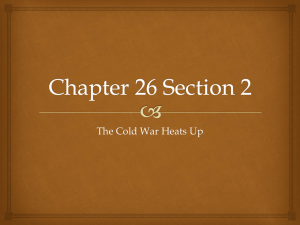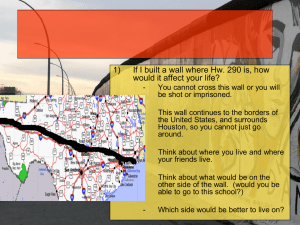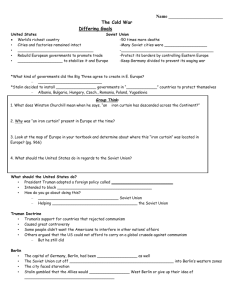“Ronald Reagan and the Ending of the Cold War” Barbara Fowler
advertisement
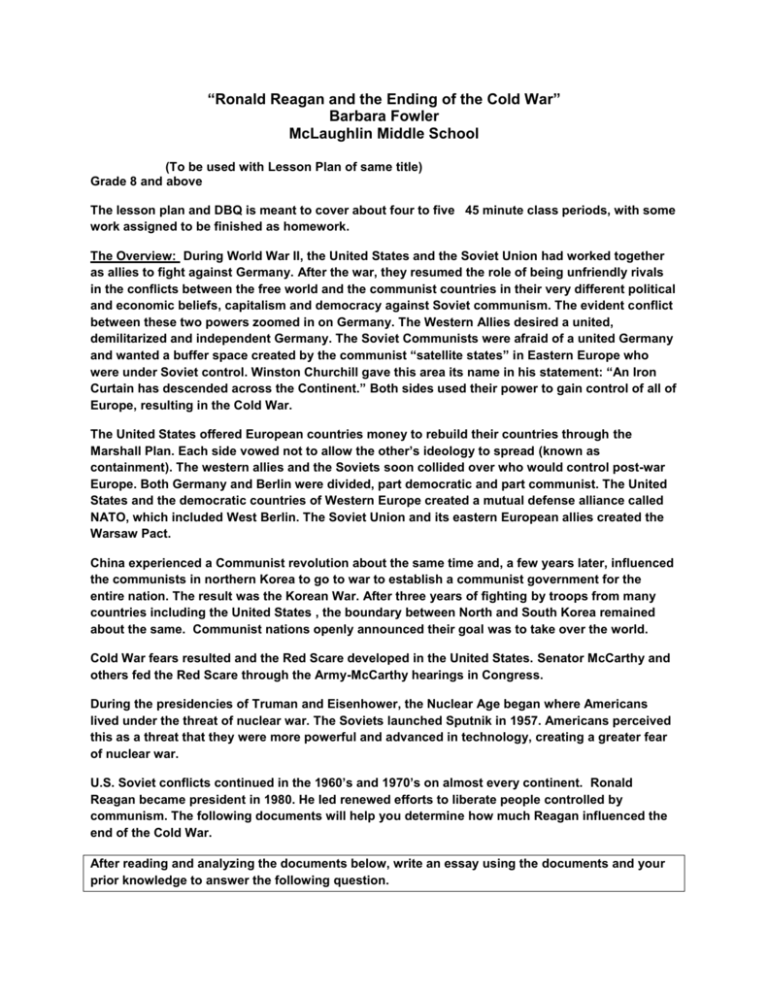
“Ronald Reagan and the Ending of the Cold War” Barbara Fowler McLaughlin Middle School (To be used with Lesson Plan of same title) Grade 8 and above The lesson plan and DBQ is meant to cover about four to five 45 minute class periods, with some work assigned to be finished as homework. The Overview: During World War II, the United States and the Soviet Union had worked together as allies to fight against Germany. After the war, they resumed the role of being unfriendly rivals in the conflicts between the free world and the communist countries in their very different political and economic beliefs, capitalism and democracy against Soviet communism. The evident conflict between these two powers zoomed in on Germany. The Western Allies desired a united, demilitarized and independent Germany. The Soviet Communists were afraid of a united Germany and wanted a buffer space created by the communist “satellite states” in Eastern Europe who were under Soviet control. Winston Churchill gave this area its name in his statement: “An Iron Curtain has descended across the Continent.” Both sides used their power to gain control of all of Europe, resulting in the Cold War. The United States offered European countries money to rebuild their countries through the Marshall Plan. Each side vowed not to allow the other’s ideology to spread (known as containment). The western allies and the Soviets soon collided over who would control post-war Europe. Both Germany and Berlin were divided, part democratic and part communist. The United States and the democratic countries of Western Europe created a mutual defense alliance called NATO, which included West Berlin. The Soviet Union and its eastern European allies created the Warsaw Pact. China experienced a Communist revolution about the same time and, a few years later, influenced the communists in northern Korea to go to war to establish a communist government for the entire nation. The result was the Korean War. After three years of fighting by troops from many countries including the United States , the boundary between North and South Korea remained about the same. Communist nations openly announced their goal was to take over the world. Cold War fears resulted and the Red Scare developed in the United States. Senator McCarthy and others fed the Red Scare through the Army-McCarthy hearings in Congress. During the presidencies of Truman and Eisenhower, the Nuclear Age began where Americans lived under the threat of nuclear war. The Soviets launched Sputnik in 1957. Americans perceived this as a threat that they were more powerful and advanced in technology, creating a greater fear of nuclear war. U.S. Soviet conflicts continued in the 1960’s and 1970’s on almost every continent. Ronald Reagan became president in 1980. He led renewed efforts to liberate people controlled by communism. The following documents will help you determine how much Reagan influenced the end of the Cold War. After reading and analyzing the documents below, write an essay using the documents and your prior knowledge to answer the following question. How Did Ronald Reagan Influence the Ending of the Cold War during his term in office? http://www.slate.com/id/2102081/ Gorbachev and Reagan Vice President George Bush, President Reagan and Mikhail Gorbachev meet in New York on Governors Island during the Soviet president's visit in December 1988. (http://www.newsday.com/news/la-reagan-whitehouse-pg,0,2287028.photogalleryAP) The Documents: Document A: The Cold War in Maps—showing the growth of countries. Document B: the Baldy Cartoon on the Cold War Document C: Reagan’s Berlin Wall Speech, June, 1987 Document D: Political Cartoon: Gorbachev looking at a broken sickle Document E: Political Cartoon showing Change Document F: Political Cartoon--Pension for Military in Estonia Document G: INTERMEDIATE-RANGE NUCLEAR FORCES TREATY MESSAGE FROM THE PRESIDENT OF THE UNITED STATES TRANSMITTING First Day: The Hook: Review with the students about the overview leading to the end of the Cold War. Make a timeline using the review facts from the overview as well as using the textbook showing the conflicts in the Cold War. Document A: The Cold War 1945-1960 The Cold War 1960-1991 http://users.erols.com/mwhite28/coldwar2.htm Questions: 1. Compare the two maps and discuss the size and expansion of the start and toward the end of the countries on each side. ____________________________________________________________________________ 2. List the countries that are Communist. Document B: The Baldy cartoon on the Cold War: Title [Baldy cartoon on the Cold War] / by Baldy, [ca. 1947]. Abstract The Clifford "Baldy" Baldowski cartoon depicts Uncle Sam's arm, labeled "Marshall Plan," handing a Soviet bear a piece of paper labeled "peace." The bear is tearing into it with his teeth. Publishe [Atlanta, Ga. : Atlanta Constitution, ca. 1947] d Notes Forms part of the Clifford H. Baldowski Editorial Cartoon Collection. | The Baldowski cartoons created for The Atlanta Journal Constitution are licensed to the Richard B. Russell Library for Political Research and Studies, University of Georgia Libraries by The Atlanta Journal Constitution. Location Richard B. Russell Library for Political Research and Studies, The University of Georgia Libraries, Athens, Georgia, 30602-1641. Questions from the Cartoon: 3. What time period was this cartoon published?_________________________ (Search for the publication and year.) 4. Read the abstract description above the cartoon. Describe what is represented: 5. What type of emotion is shown by the symbols represented? Review again from the background overview and read the following: Remember the tension that resulted from the Berlin Wall in the year 1961. Document C: Reagan’s Berlin Wall Speech, June, 1987 Berlin Wall Speech June 12, 1987 Thank you very much. Chancellor Kohl, Governing Mayor Diepgen, ladies and gentlemen: Twenty-four years ago, President John F. Kennedy visited Berlin, speaking to the people of this city and the world at the City Hall. Well, since then two other presidents have come, each in his turn, to Berlin. And today I, myself, make my second visit to your city. We come to Berlin, we American presidents, because it's our duty to speak, in this place, of freedom. But I must confess, we're drawn here by other things as well: by the feeling of history in this city, more than 500 years older than our own nation; by the beauty of the Grunewald and the Tiergarten; most of all, by your courage and determination. Perhaps the composer Paul Lincke understood something about American presidents. You see, like so many presidents before me, I come here today because wherever I go, whatever I do: Ich hab noch einen Koffer in Berlin. [I still have a suitcase in Berlin.] Our gathering today is being broadcast throughout Western Europe and North America. I understand that it is being seen and heard as well in the East. To those listening throughout Eastern Europe, a special word: Although I cannot be with you, I address my remarks to you just as surely as to those standing here before me. For I join you, as I join your fellow countrymen in the West, in this firm, this unalterable belief: Es gibt nur ein Berlin. [There is only one Berlin.] Behind me stands a wall that encircles the free sectors of this city, part of a vast system of barriers that divides the entire continent of Europe. From the Baltic, south, those barriers cut across Germany in a gash of barbed wire, concrete, dog runs, and guard towers. Farther south, there may be no visible, no obvious wall. But there remain armed guards and checkpoints all the same--still a restriction on the right to travel, still an instrument to impose upon ordinary men and women the will of a totalitarian state. Yet it is here in Berlin where the wall emerges most clearly; here, cutting across your city, where the news photo and the television screen have imprinted this brutal division of a continent upon the mind of the world. Standing before the Brandenburg Gate, every man is a German, separated from his fellow men. Every man is a Berliner, forced to look upon a scar. President von Weizsacker has said, "The German question is open as long as the Brandenburg Gate is closed." Today I say: As long as the gate is closed, as long as this scar of a wall is permitted to stand, it is not the German question alone that remains open, but the question of freedom for all mankind. Yet I do not come here to lament. For I find in Berlin a message of hope, even in the shadow of this wall, a message of triumph. In this season of spring in 1945, the people of Berlin emerged from their air-raid shelters to find devastation. Thousands of miles away, the people of the United States reached out to help. And in 1947 Secretary of State--as you've been told--George Marshall announced the creation of what would become known as the Marshall Plan. Speaking precisely 40 years ago this month, he said: "Our policy is directed not against any country or doctrine, but against hunger, poverty, desperation, and chaos." In the Reichstag a few moments ago, I saw a display commemorating this 40th anniversary of the Marshall Plan. I was struck by the sign on a burnt-out, gutted structure that was being rebuilt. I understand that Berliners of my own generation can remember seeing signs like it dotted throughout the western sectors of the city. The sign read simply: "The Marshall Plan is helping here to strengthen the free world." A strong, free world in the West, that dream became real. Japan rose from ruin to become an economic giant. Italy, France, Belgium--virtually every nation in Western Europe saw political and economic rebirth; the European Community was founded. In West Germany and here in Berlin, there took place an economic miracle, the Wirtschaftswunder. Adenauer, Erhard, Reuter, and other leaders understood the practical importance of liberty--that just as truth can flourish only when the journalist is given freedom of speech, so prosperity can come about only when the farmer and businessman enjoy economic freedom. The German leaders reduced tariffs, expanded free trade, lowered taxes. From 1950 to 1960 alone, the standard of living in West Germany and Berlin doubled. Where four decades ago there was rubble, today in West Berlin there is the greatest industrial output of any city in Germany--busy office blocks, fine homes and apartments, proud avenues, and the spreading lawns of parkland. Where a city's culture seemed to have been destroyed, today there are two great universities, orchestras and an opera, countless theaters, and museums. Where there was want, today there's abundance--food, clothing, automobiles--the wonderful goods of the Ku'damm. From devastation, from utter ruin, you Berliners have, in freedom, rebuilt a city that once again ranks as one of the greatest on earth. The Soviets may have had other plans. But my friends, there were a few things the Soviets didn't count on--Berliner Herz, Berliner Humor, ja, und Berliner Schnauze. [Berliner heart, Berliner humor, yes, and a Berliner Schnauze.] In the 1950s, Khrushchev predicted: "We will bury you." But in the West today, we see a free world that has achieved a level of prosperity and well-being unprecedented in all human history. In the Communist world, we see failure, technological backwardness, declining standards of health, even want of the most basic kind--too little food. Even today, the Soviet Union still cannot feed itself. After these four decades, then, there stands before the entire world one great and inescapable conclusion: Freedom leads to prosperity. Freedom replaces the ancient hatreds among the nations with comity and peace. Freedom is the victor. And now the Soviets themselves may, in a limited way, be coming to understand the importance of freedom. We hear much from Moscow about a new policy of reform and openness. Some political prisoners have been released. Certain foreign news broadcasts are no longer being jammed. Some economic enterprises have been permitted to operate with greater freedom from state control. Are these the beginnings of profound changes in the Soviet state? Or are they token gestures, intended to raise false hopes in the West, or to strengthen the Soviet system without changing it? We welcome change and openness; for we believe that freedom and security go together, that the advance of human liberty can only strengthen the cause of world peace. There is one sign the Soviets can make that would be unmistakable, that would advance dramatically the cause of freedom and peace. General Secretary Gorbachev, if you seek peace, if you seek prosperity for the Soviet Union and Eastern Europe, if you seek liberalization: Come here to this gate! Mr. Gorbachev, open this gate! Mr. Gorbachev, tear down this wall! I understand the fear of war and the pain of division that afflict this continent-- and I pledge to you my country's efforts to help overcome these burdens. To be sure, we in the West must resist Soviet expansion. So we must maintain defenses of unassailable strength. Yet we seek peace; so we must strive to reduce arms on both sides. Beginning 10 years ago, the Soviets challenged the Western alliance with a grave new threat, hundreds of new and more deadly SS-20 nuclear missiles, capable of striking every capital in Europe. The Western alliance responded by committing itself to a counter-deployment unless the Soviets agreed to negotiate a better solution; namely, the elimination of such weapons on both sides. For many months, the Soviets refused to bargain in earnestness. As the alliance, in turn, prepared to go forward with its counter-deployment, there were difficult days--days of protests like those during my 1982 visit to this city--and the Soviets later walked away from the table. But through it all, the alliance held firm. And I invite those who protested then-- I invite those who protest today--to mark this fact: Because we remained strong, the Soviets came back to the table. And because we remained strong, today we have within reach the possibility, not merely of limiting the growth of arms, but of eliminating, for the first time, an entire class of nuclear weapons from the face of the earth. As I speak, NATO ministers are meeting in Iceland to review the progress of our proposals for eliminating these weapons. At the talks in Geneva, we have also proposed deep cuts in strategic offensive weapons. And the Western allies have likewise made far-reaching proposals to reduce the danger of conventional war and to place a total ban on chemical weapons. While we pursue these arms reductions, I pledge to you that we will maintain the capacity to deter Soviet aggression at any level at which it might occur. And in cooperation with many of our allies, the United States is pursuing the Strategic Defense Initiative--research to base deterrence not on the threat of offensive retaliation, but on defenses that truly defend; on systems, in short, that will not target populations, but shield them. By these means we seek to increase the safety of Europe and all the world. But we must remember a crucial fact: East and West do not mistrust each other because we are armed; we are armed because we mistrust each other. And our differences are not about weapons but about liberty. When President Kennedy spoke at the City Hall those 24 years ago, freedom was encircled, Berlin was under siege. And today, despite all the pressures upon this city, Berlin stands secure in its liberty. And freedom itself is transforming the globe. In the Philippines, in South and Central America, democracy has been given a rebirth. Throughout the Pacific, free markets are working miracle after miracle of economic growth. In the industrialized nations, a technological revolution is taking place--a revolution marked by rapid, dramatic advances in computers and telecommunications. In Europe, only one nation and those it controls refuse to join the community of freedom. Yet in this age of redoubled economic growth, of information and innovation, the Soviet Union faces a choice: It must make fundamental changes, or it will become obsolete. Today thus represents a moment of hope. We in the West stand ready to cooperate with the East to promote true openness, to break down barriers that separate people, to create a safe, freer world. And surely there is no better place than Berlin, the meeting place of East and West, to make a start. Free people of Berlin: Today, as in the past, the United States stands for the strict observance and full implementation of all parts of the Four Power Agreement of 1971. Let us use this occasion, the 750th anniversary of this city, to usher in a new era, to seek a still fuller, richer life for the Berlin of the future. Together, let us maintain and develop the ties between the Federal Republic and the Western sectors of Berlin, which is permitted by the 1971 agreement. And I invite Mr. Gorbachev: Let us work to bring the Eastern and Western parts of the city closer together, so that all the inhabitants of all Berlin can enjoy the benefits that come with life in one of the great cities of the world. To open Berlin still further to all Europe, East and West, let us expand the vital air access to this city, finding ways of making commercial air service to Berlin more convenient, more comfortable, and more economical. We look to the day when West Berlin can become one of the chief aviation hubs in all central Europe. Questions: 6. What is meant by Reagan sharing the phrase “I still have a suitcase in Berlin?”_______________________________________________________________ 7. Why was Reagan at the Berlin Wall?________________________________________________________________________ __ ." ___________________________________________________________________________ 8. Consider the following quote from the speech: Today I say: As long as the gate is closed, as long as this scar of a wall is permitted to stand, it is not the German question alone that remains open, but the question of freedom for all mankind. Yet I do not come here to lament. For I find in Berlin a message of hope, even in the shadow of this wall, a message of triumph.” What is the wound and scar important to the Germans and what is desired?___________________________________________________________________ 9. Discuss the importance of the following: In West Germany and here in Berlin, there took place an economic miracle, the Wirtschaftswunder. Adenauer, Erhard, Reuter, and other leaders understood the practical importance of liberty--that just as truth can flourish only when the journalist is given freedom of speech, so prosperity can come about only when the farmer and businessman enjoy economic freedom. The German leaders reduced tariffs, expanded free trade, lowered taxes. From 1950 to 1960 alone, the standard of living in West Germany and Berlin doubled. _____________________________________________________________________________ _____________________________________________________________________________ _____________________________________________________________________________ _____________________________________________________________________________ 10. Discuss the importance of this speech and how it affected Berlin:_______________________________________________________________________ _____________________________________________________________________________ _____________________________________________________________________________ _____________________________________________________________________________ _____________________________________________________________________________ ____________________________________________________________________________ Document D: Political Cartoon showing Gorbachev looking at a crushed sickle. http://dbs.galib.uga.edu/bald/html/bald_homeframe_default.html One of a new generation of Soviet leaders who ascended to power in 1980s, Mikhail S. Gorbachev (1931- ) implemented political and cultural reforms such as perestroika (restructuring of the Russian economy) and glasnost (new "openness"). By 1991 he faced challenges from the deteriorating Soviet economy, communist hard liners, nationalists and secessionists who desired independence for their republics. Though hard-liners staged a coup in August, 1991, and placed him under house arrest, reformers re-instated him to power within three days. Valtman portrays a sober Gorbachev surveying the once solid symbol of Soviet unity, now a fragme [Gorbachev beholds a crushed hammer and sickle], 1991 Published in: The Waterbury Republican and The Middletown press, 1991; The best editorial cartoons of the year, 1992, p. 14; Edmund Valtman, Valtman: The Editorial Cartoons of Edmund S. Valtman, 1961-1991. Baltimore, MD: Esto, Inc., 1991, p. 13. Ink, tonal overlay on paper Prints & Photographs Division (20) LC-USZ62-130437nted stone ruin. Questions: 11. What happened to Gorbachev in August, 1991?_________________________ 12. Why do you think he wanted reform in that he was re-instated to power shortly after the coup?_____________________________________________________ 13. Discuss the importance of the symbolism in the cartoon:_______________________________________________________________ ______________________________________________________________________ ______________________________________________________________________ Document E: Political Cartoon showing Change Between 1985 and 1990 Soviet leader Mikhail S. Gorbachev (1931- ) steered Russia's foreign relations in a new conciliatory direction by working with Presidents Reagan and Bush to sign a series of arms control agreements, withdrawing Soviet troops from Afghanistan, and improving relations with China. He also transferred power from the Communist Party to elected legislatures in Russia's union republics. Such developments, along with the fall of the Berlin Wall and unification of East and West Germany, signaled the end of the Cold War. Gorbachev leads the funeral procession in Valtman's imaginative, skillfully realized drawing which memorializes the demise of communism as its hallowed trinity-Karl Marx (1818-1883), Vladimir Lenin (1870-1924), and Joseph Stalin (1879-1953) look on in consternation. I Can't Believe My Eyes!, 1991 Published in: The Waterbury Republican and The Middletown press, 1991; The best editorial cartoons of the year, 1992, p. 21; Edmund Valtman, Valtman: The Editorial Cartoons of Edmund S. Valtman, 1961-1991. Baltimore, MD: Esto, Inc., 1991, p. 15. Ink, tonal overlay on paper Prints & Photographs Division (21) LC-USZ62-130438 Questions: 14. What did Gobochev work on with Reagan and later Bush in the area of the military? ______________________________________________________________________ 15. Why are the former rulers of the Soviet Union looking down seeing a coffin being led by the current ruler? _______________________________________________________________________________ 16. Why are they in disbelief?__________________________________________________ Document F: Pension for Military in Estonia In 1944, Russian troops drove the Germans out of Estonia and immediately incorporated it into the Soviet Union. Fifty years later, with the fall of the Iron Curtain, Estonia had declared its independence, but Russian leader Boris Yeltsin (1931- ) refused to remove the last 2000 Russian troops until the Estonian government agreed to provide former Russian officers who had retired there with citizenship, housing, and pensions. Under pressure from the United States, the Russians eventually backed down. Ink, tonal overlay on paper Prints & Photographs Division (22) LC-USZ62-130447 http://www.loc.gov/rr/print/swann/valtman/presentation.html Questions: 17. Using this cartoon as an example of the many satellite eastern block countries, what does this cartoon represent?_____________________________________________________________________ 18. What does the fifty years represent?_____________________________________________________ 19. Were the Russians successful for their military to be paid by Estonia?_________________________ Document G: INTERMEDIATE-RANGE NUCLEAR FORCES TREATY MESSAGE FROM THE PRESIDENT OF THE UNITED STATES TRANSMITTING with photo C44071-15A, President Reagan and Soviet General Secretary Gorbachev signing the INF Treaty in the East Room of the White House. 12/8/87. INTERMEDIATE-RANGE NUCLEAR FORCES TREATY MESSAGE FROM THE PRESIDENT OF THE UNITED STATES TRANSMITTING The Treaty between the United States of America and the Union of Soviet Socialist Republics on the Elimination of Their Intermediate-Range and Shorter-Range Missiles, Together with the Memorandum of Understanding and Two Protocols, Signed at Washington on December 8, 1987 LETTER OF TRANSMITTAL The White House, January 25, 1988 To the Senate of the United States: I am transmitting herewith, for the advice and consent of the Senate to ratification, the Treaty between the United States of America and the Union of Soviet Socialist Republics on the Elimination of Their Intermediate-Range and Shorter-Range Missiles (the Treaty). The Treaty includes the following documents, which are integral parts thereof: the Memorandum of Understanding (the MOU) regarding the establishment of a data base, the Protocol on Elimination governing the elimination of missile systems, and the Protocol on Inspection regarding the conduct of inspections, with an Annex to that Protocol on the privileges and immunities to be accorded inspectors and aircrew members. The Treaty, together with the MOU and the two Protocols, was signed at Washington on December 8, 1987. The Report of the Department of State on the Treaty is provided for the information of the Senate. In addition, I am transmitting herewith, for the information of the Senate, the Agreement Among the United States of America and the Kingdom of Belgium, the Federal Republic of Germany, the Republic of Italy, the Kingdom of the Netherlands, and the United Kingdom of Great Britain and Northern Ireland Regarding Inspections Relating to the Treaty Between the United States of America and the Union of Soviet Socialist Republics on the Elimination of Their IntermediateRange and Shorter-Range Missiles (the Basing Country Agreement), which was signed at Brussels on December 11, 1987. The Basing Country Agreement confirms that the inspections called for in the Treaty will be permitted by the five Allied Basing Countries. The Report of the Department of State discusses in detail the terms of the Basing Country Agreement. Also attached for the information of the Senate are the notes exchanged between both the German Democratic Republic and Czechoslovakia and the United States. The notes acknowledge that these countries agree to the United States' conducting inspections, under the Treaty, on their territory. Identical notes also are being exchanged between the Soviet Union and the five Allied Basing Countries. The Treaty is an unprecedented arms control agreement in several respects. It marks the first time that the United States and the Soviet Union have agreed to eliminate, throughout the world, an entire class of their missile systems. Significantly, the elimination will be achieved from markedly asymmetrical starting points that favored the Soviet Union. The Treaty includes provisions for comprehensive on-site inspections, including the continuous monitoring of certain facilities, to aid in verifying compliance. To a much greater extent than in earlier arms control agreements between the United States and the Soviet Union, detailed information has been, and will continue to be, exchanged by the Parties in order to facilitate verification of compliance. Finally, the United States and the Soviet Union have agreed on cooperative measures to enhance verification by national technical means. The missile systems to be eliminated consist of all U.S. and Soviet ground-launched ballistic missiles and ground-launched cruise missiles having a range capability between 500 and 5500 kilometers. The launchers for such missiles and unique elements of their related support structures and support equipment also will be eliminated. The shorter-range missiles to be eliminated under this Treaty are those with a range capability between 500 and 1000 kilometers. They must be eliminated within 18 months after the entry into force of the Treaty. Intermediaterange missiles, having a range capability between 1000 and 5500 kilometers, are to be eliminated in two phases within three years after the entry into force of the Treaty. Elimination will take place at designated locations and will be subject to on-site inspection as an aid to verifying compliance. In the MOU, the United States and the Soviet Union have provided detailed information on the location of all missiles, launchers, and related support structures and support equipment subject to the Treaty. Each Party is required to provide updated information on a routine basis after the Treaty enters into force. The Treaty provides that on-site inspections are permitted at specified locations in the United States and the Soviet Union as well as in the Basing Countries in Western and Eastern Europe where U.S. or Soviet missiles, launchers, and related support structures and support equipment subject to the Treaty are or have been located. The different types of "short-notice" on-site inspections for which the Treaty provides are designed to contribute to our ability to verify Soviet compliance, while protecting all U.S. and Allied nuclear and conventional forces not subject to the Treaty as well as other sensitive intelligence and defense facilities. In addition to "short-notice" on-site inspections, the Treaty provides for other types of on-site inspections, including the continuous presence of U.S. inspectors at the Soviet facility at Votkinsk, at which SS-25 and SS-20 missiles have been assembled, and a continuous Soviet presence at the identified facility at Hercules Plant #1, located at Magna, Utah, at which stages of Pershing II missiles formerly were produced. The Treaty is the culmination of six years of negotiations with the Soviet Union. To a large extent, the Treaty is the result of Allied solidarity in support of the fundamental objectives established by NATO's "dual-track" decision in 1979. Our Atlantic and our Asian and Pacific Allies have been closely involved throughout the period of negotiation, and they fully support the Treaty. The Treaty enhances our collective security by eliminating an entire class of Soviet missile systems that has been a major concern for over a decade. Our European Allies will continue to be well protected by the significant U.S. nuclear forces remaining in Europe, by the independent British and French nuclear deterrents, and by conventional forces, which include over 300,000 U.S. troops. Questions: The above treaty is just a portion of it. Carefully read through it and answer the following: 20. List the countries that were mentioned and involved from the second paragraph:______ _______________________________________________________________________ 21. It states that it is an unprecedented arms control agreement in several respects. Discuss what this means.____________________________________________________________ _______________________________________________________________________ 22. What do the missiles systems consist of?________________________________________ 23. Explain the significance of the locations being cited._____________________________ 24. How long were the negotiations to get to this point in the treaty?_____________________ Part II: Directions: Using the documents, the answers in Part I, and your knowledge of the events surrounding World War II, the facts of the Marshall Plan, the weakening of power in Germany from the Communist, and the documents showing Reagan’s involvement, consider all for the following DBQ question. DBQ Question: Discuss Reagan’s involvement and the previous power of the USSR in Europe coming to the point of the Berlin Wall and the Cold War ending. Consider how Reagan was influential in ending the Cold War. From the overview: Years pass into the 1980s when Ronald Reagan became president. Considering that communism was very suppressing, he took advantage of the countries being overburdened and controlled by the U.S.S.R. The following documents will help you determine how much Reagan influenced the end of the Cold War. This will be the DBQ main thrust in answering the question: How Did Ronald Reagan Influence the Ending of the Cold War during his term in office Question: How was the Cold War finally brought to an end through the efforts of Reagan and Gorbachev and what was the significance of this for both countries and the world?___________________________________________________________________ ________________________________________________________________________ ________________________________________________________________________ ________________________________________________________________________ ________________________________________________________________________ ________________________________________________________________________ ________________________________________________________________________ ________________________________________________________________________ ________________________________________________________________________ ________________________________________________________________________ ________________________________________________________________________ ________________________________________________________________________ ________________________________________________________________________ ________________________________________________________________________ ________________________________________________________________________ ________________________________________________________________________ ________________________________________________________________________ _______________________________________________________________________ _________________________________________________________________________________ _________________________________________________________________________________ _________________________________________________________________________________ _________________________________________________________________________________ _________________________________________________________________________________ _________________________________________________________________________________ _________________________________________________________________________________ _________________________________________________________________________________ _________________________________________________________________________________ _________________________________________________________________________________ _________________________________________________________________________________ _________________________________________________________________________________
